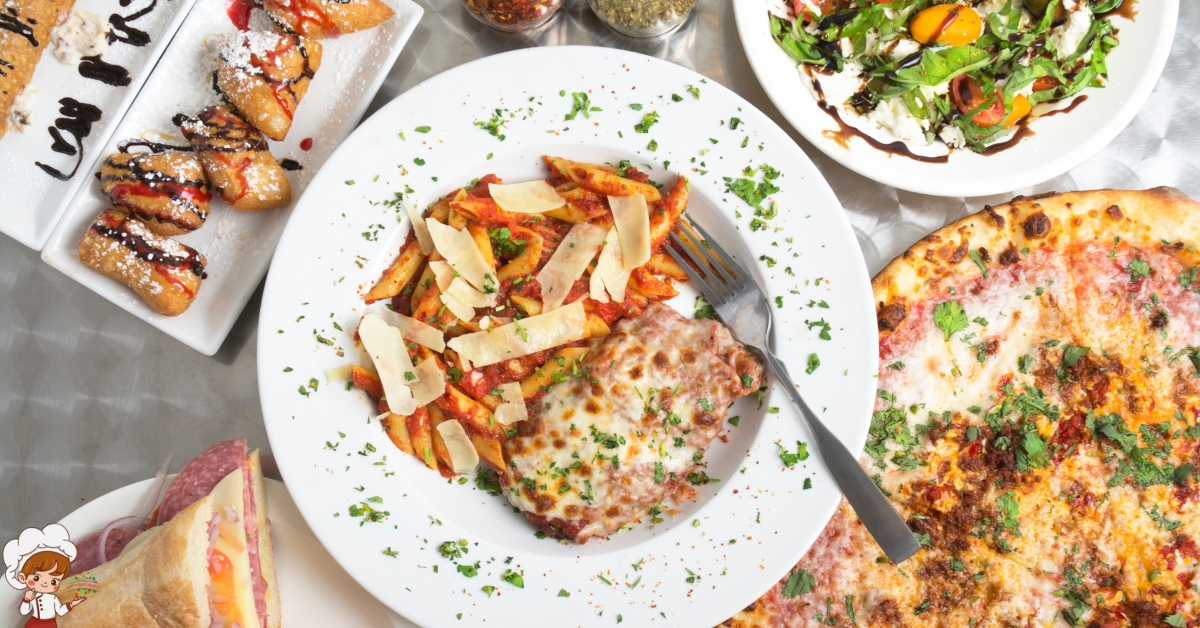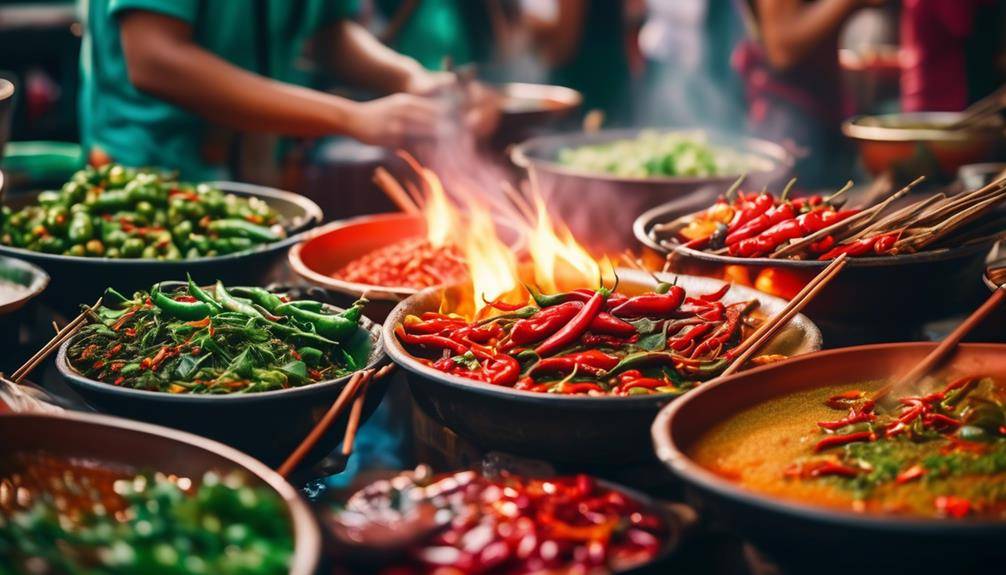Popular Italian Food Traditions And Customs

Italian Food Traditions And Customs; Did you know that Italian food traditions and customs are deeply rooted in family and community? Italy is known for its diverse cuisine, but there are many aspects of Italian food culture that you may not be familiar with. From the importance of family meals to the significance of seasonal ingredients, Italian food traditions go beyond just cooking and eating.
In this guide, we will explore the regional specialties, traditional cooking techniques, and the role of pasta and pizza in Italian cuisine. We will also delve into the art of wine and food pairing, the festive celebrations around Italian food, and the proper etiquette and table manners that are followed in Italy. Get ready to embark on a delicious journey through Italian food traditions and customs!
The Importance of Family Meals
When it comes to Italian food traditions and customs, one cannot underestimate the importance of gathering around the table with your family for a meal. Family meals hold a deep cultural significance in Italy, representing more than just a time to eat. They serve as a cornerstone for family bonding and a way to pass down traditions and values from one generation to the next.
The importance of family bonding during mealtime cannot be overstated. It is a time when family members come together, share food, and engage in meaningful conversations. This fosters a sense of belonging and strengthens the family unit. Through shared meals, family members create lasting memories and develop a strong emotional connection, building a foundation of love and support.
In Italy, the cultural significance of shared meals extends beyond the immediate family. It is common for extended family members, friends, and neighbors to gather around the table. This emphasizes the value placed on community and the importance of building relationships. These gatherings often involve multiple courses, allowing ample time for conversation and creating a relaxed atmosphere where people can truly connect.
Shared meals also play a vital role in passing down traditions and cultural values. Recipes are shared, traditional dishes are prepared, and stories are told. This allows younger generations to learn about their heritage and understand the customs and values that shape their identity. Family meals become a way to preserve and celebrate Italian culture, ensuring that it continues to thrive for years to come.
Regional Specialties
When it comes to Italian cuisine, one cannot overlook the incredible diversity of regional specialties. From the rich and hearty dishes of the North to the lighter and seafood-based delicacies of the South, each region offers its own unique culinary traditions. Whether it’s the famous Neapolitan pizza or the creamy risotto of Lombardy, exploring the regional specialties of Italy is like taking a journey through the country’s rich gastronomic heritage.
Unique Regional Dishes
Indulge in the diverse flavors of Italy through its unique regional dishes, each showcasing the rich culinary heritage of its respective area. Italy’s regional culinary traditions have been shaped by historical influences, resulting in a wide array of distinctive dishes. In the northern region of Lombardy, you can savor the famous risotto alla Milanese, a creamy rice dish flavored with saffron. In the central region of Tuscany, indulge in the hearty bistecca alla fiorentina, a succulent grilled T-bone steak.
Head south to Campania and try the traditional Neapolitan pizza, with its thin, crispy crust and flavorful toppings. And in Sicily, sample the arancini, deep-fried rice balls filled with meat or cheese. These unique regional dishes not only satisfy your taste buds but also provide a glimpse into the culinary history and cultural diversity of Italy.
Culinary Diversity Across Italy
As you explore the rich culinary heritage of Italy’s unique regional dishes, you will discover the remarkable culinary diversity across the country, with each region offering its own specialties. The culinary traditions of Italy vary greatly from one region to another, showcasing the country’s rich cultural history and geographical influences. Here are four examples of regional cuisines that exemplify the diversity of Italian food:
- In the north, the region of Lombardy is known for its hearty dishes like Risotto alla Milanese, a saffron-infused rice dish, and Ossobuco, a braised veal shank.
- In central Italy, Tuscany stands out with its rustic cuisine, featuring dishes like Ribollita, a vegetable and bread soup, and Bistecca alla Fiorentina, a thick cut of grilled steak.
- Moving south to Campania, you’ll find Naples, the birthplace of pizza. Neapolitan pizza is known for its thin, crispy crust and fresh ingredients like San Marzano tomatoes and buffalo mozzarella.
- Finally, in Sicily, you can indulge in unique flavors influenced by Arab, Greek, and Spanish cultures. Try Arancini, fried rice balls stuffed with meat or cheese, or Pasta alla Norma, a pasta dish with eggplant, tomatoes, and ricotta salata.
Traditional Italian Cooking Techniques
Now let’s explore the traditional cooking techniques that make Italian cuisine so unique. From authentic pasta-making methods to the regional culinary influences, these techniques play a crucial role in shaping the flavors and textures of Italian dishes. By understanding these techniques, you can gain a deeper appreciation for the rich culinary traditions that have been passed down through generations in Italy.
Authentic Pasta-Making Methods
To master the art of traditional Italian pasta-making techniques, you must understand the importance of using fresh, high-quality ingredients. Authentic pasta making in Italy is a cherished tradition passed down through generations. Here are four key elements that contribute to the authenticity of Italian pasta:
- Flour: Italians typically use semolina flour, which is made from durum wheat, to create the perfect texture and flavor in their pasta.
- Eggs: While some pasta recipes call for only flour and water, traditional Italian pasta often includes eggs. This ingredient adds richness and enhances the color of the pasta.
- Hand Kneading: Italian pasta makers believe that hand-kneading is essential to achieve the right consistency and texture. The process requires patience and skill.
- Drying: After the pasta is shaped, it is left to dry before cooking. This step ensures that the pasta will maintain its shape and texture when cooked.
Regional Culinary Influences
Explore the diverse regional culinary influences that shape traditional Italian cooking techniques. Italy’s culinary traditions are deeply rooted in its rich history and diverse geography. Each region in Italy has its own unique culinary traditions, influenced by factors such as climate, local ingredients, and cultural heritage. From the seafood-focused cuisine of coastal regions like Liguria and Campania to the hearty meat-based dishes of Emilia-Romagna and Tuscany, the regional variations in Italian cooking techniques are vast.
The use of local ingredients is a key aspect of traditional Italian cooking, with each region boasting its own specialty products. For example, the use of olive oil in Southern Italian cuisine and the abundance of fresh seafood in the coastal regions greatly influence the cooking techniques and flavors of these areas. Understanding the regional culinary influences is essential for truly experiencing the depth and diversity of traditional Italian cuisine.
The Role of Pasta in Italian Cuisine
One of the most prominent aspects of Italian cuisine is the countless varieties of pasta available to you. From spaghetti and lasagna to penne and tortellini, pasta dishes are a staple in Italian households and restaurants. Here are four reasons why pasta plays such a significant role in Italian cuisine:
- Versatility of pasta dishes: Pasta can be prepared in numerous ways, making it a versatile ingredient in Italian cooking. Whether it’s a simple aglio e olio or a rich carbonara, pasta dishes can be customized with various sauces, meats, vegetables, and cheeses to suit different tastes and preferences. This versatility allows for endless culinary creativity and experimentation.
- Traditional recipes and family traditions: Pasta recipes have been passed down through generations in Italian families, preserving the authenticity and cultural significance of the dish. Each region in Italy has its own traditional pasta recipe, showcasing the diversity and richness of Italian cuisine. These recipes often reflect the local ingredients and culinary traditions of the area.
- Nutritional value and health benefits of pasta: Contrary to popular belief, pasta can be a healthy and nutritious choice. It is a good source of complex carbohydrates, which provide sustained energy to the body. Pasta also contains important nutrients such as fiber, iron, and B vitamins. When paired with a variety of vegetables, lean proteins, and healthy fats, pasta can contribute to a balanced diet.
- Symbol of togetherness and communal dining: In Italy, pasta is not just a meal, but a social experience. It is often enjoyed with family and friends, bringing people together around the table. The act of sharing a plate of pasta promotes conversation, laughter, and a sense of community. This aspect of pasta is deeply ingrained in Italian culture and contributes to the overall enjoyment and appreciation of the dish.
Italian Pizza: A Culinary Icon
Italian pizza holds a prominent place in Italian cuisine due to its unique flavors, cultural significance, and widespread popularity. When delving into the culinary history of Italy, pizza is an iconic dish that cannot be overlooked. The origins of pizza can be traced back to ancient times, with evidence of flatbreads topped with various ingredients being consumed by the ancient Greeks and Egyptians. However, it was in Naples, Italy, where the modern pizza as we know it today originated.
Naples, renowned for its vibrant food culture, contributed significantly to the development of pizza. In the late 18th century, pizza gained popularity among the working class in Naples, who sought a quick and affordable meal. It was in Naples that the iconic Margherita pizza was created, representing the colors of the Italian flag with its toppings of tomato sauce, mozzarella cheese, and fresh basil. This simple yet flavorful combination remains a favorite among pizza enthusiasts worldwide.
The traditional Neapolitan pizza has a thin, chewy crust, thanks to the use of high-protein wheat flour and a slow fermentation process. The toppings used on Italian pizza vary greatly, depending on regional preferences and personal taste. While the classic Margherita remains a staple, other iconic toppings include pepperoni, mushrooms, artichokes, and olives. Each topping adds its unique touch, enhancing the overall taste and experience of the pizza.
Italian pizza has transcended borders and has become a global culinary sensation. Its versatility allows for endless variations and creative interpretations, making it a favorite choice for people of all ages and backgrounds. Whether enjoyed in a traditional pizzeria in Naples or a trendy pizza joint in New York City, Italian pizza continues to captivate taste buds and play a significant role in the cultural exchange of flavors and traditions.
Classic Italian Desserts and Sweets
You often find yourself indulging in the delectable world of classic Italian desserts and sweets. From the creamy richness of classic Italian gelato to the crunchy perfection of traditional biscotti recipes, Italian desserts have a long-standing reputation for their exquisite flavors and textures. Here are four classic Italian desserts and sweets that are sure to satisfy your sweet tooth:
- Classic Italian Gelato: Gelato is a frozen treat that is similar to ice cream but with a denser and silkier texture. Made with a higher proportion of milk to cream, gelato is churned at a slower speed, resulting in a smoother consistency. It comes in a variety of flavors, from classic favorites like chocolate and vanilla to more unique options like pistachio and stracciatella. Whether enjoyed in a cup or on a cone, gelato is a must-try Italian dessert.
- Tiramisu: Tiramisu is a beloved Italian dessert made with layers of ladyfingers soaked in coffee and a rich mascarpone cheese filling. The combination of the sweet and slightly bitter flavors of the coffee, the creamy mascarpone, and the hint of cocoa powder on top creates a truly decadent and irresistible dessert.
- Cannoli: Originating from Sicily, cannoli are crispy pastry tubes filled with a sweet ricotta cheese filling. The filling is often flavored with ingredients like vanilla, chocolate, or citrus zest. The contrast between the crunchy shell and the creamy filling makes cannoli a delightful treat.
- Traditional Biscotti: Biscotti, meaning “twice-baked,” are crunchy almond-based cookies that are perfect for dipping into a cup of coffee or tea. They are typically flavored with ingredients like almonds, anise, or citrus zest. The double baking process gives them a satisfying crunch that pairs well with their rich flavors.
Indulge in these classic Italian desserts and sweets to experience the true essence of Italian culinary tradition.
The Significance of Seasonal Ingredients
When it comes to Italian cuisine, the use of seasonal ingredients is of utmost importance. Italians have a deep appreciation for fresh, locally sourced produce, as it enhances the flavor and quality of their dishes. By using ingredients that are in season, Italians are able to create dishes that are not only delicious, but also reflect the cultural connection to the changing seasons.
Fresh Vs. Preserved Ingredients
To fully appreciate the flavors and authenticity of Italian cuisine, it is essential to understand the importance of using seasonal ingredients. Italians have a deep respect for fresh ingredients and believe that they are the key to creating delicious and flavorful dishes. Here are four reasons why fresh ingredients are preferred over preserved ones in traditional Italian cooking:
- Flavor: Fresh ingredients have a vibrant and natural taste that cannot be replicated by preserved alternatives. The quality and intensity of flavors are at their peak when ingredients are in season.
- Nutritional Value: Fresh ingredients are packed with essential nutrients that are beneficial for your health. Preserved ingredients often lose some of their nutritional value during the preservation process.
- Texture: Fresh ingredients have a crisp and tender texture, adding depth and complexity to dishes. Preserved ingredients, on the other hand, can be softer and lack the same texture.
- Seasonality: Using seasonal ingredients ensures a connection to the land and its natural rhythms. It allows for a variety of flavors throughout the year and encourages sustainability by supporting local farmers and producers.
Cultural Connection to Seasons
Fresh ingredients are not only preferred in Italian cooking for their flavor and nutritional value, but they also hold a cultural significance due to their connection to the seasons. In Italy, cultural farming practices have been passed down for generations, emphasizing the importance of using seasonal ingredients in Italian recipes. These practices are deeply rooted in the belief that food should be enjoyed at its peak freshness, when it is naturally abundant and bursting with flavor.
Italians take pride in sourcing ingredients locally and cooking with what the land provides during each season. This not only supports local farmers and reduces the carbon footprint, but it also ensures that dishes are authentic and reflective of the time and place in which they are prepared. Seasonal ingredients in Italian recipes not only enhance the taste of the dishes but also provide a connection to the land, the traditions, and the people who cultivate and enjoy them.
Wine and Food Pairing in Italian Culture
Pairing wine with food is an integral part of Italian culture. Italians take their wine seriously and consider it as important as the food itself. Here are four key aspects of wine and food pairing in Italian culture:
- Regional Pairings: Italian cuisine is highly regional, with each region having its own unique flavors and ingredients. Italians believe that wine should be paired with the local cuisine to enhance the overall dining experience. For example, in Tuscany, the famous Chianti wine is often paired with dishes like pasta with meat sauce or grilled meats.
- Balance of Flavors: Italians believe in achieving a balance of flavors between the wine and the food. They consider the acidity, sweetness, and tannins of the wine and how they interact with the flavors of the dish. For instance, a light and crisp white wine like Pinot Grigio is often paired with seafood dishes to complement their delicate flavors.
- Complementary Pairings: Italians also look for complementary flavors in wine and food pairing. They seek to enhance the flavors of both the wine and the dish by finding common elements. For example, a rich and full-bodied red wine like Brunello di Montalcino pairs well with aged cheeses or roasted meats due to their similar bold flavors.
- Tradition and Heritage: Wine and food pairing in Italy is deeply rooted in tradition and heritage. Italians often follow time-tested combinations that have been passed down through generations. These traditional pairings are seen as a way to honor the cultural heritage and heritage of the region.
Festivals and Celebrations Around Italian Food
Immerse yourself in the vibrant festivities and joyous celebrations surrounding Italian food culture. Italy is known for its rich and diverse culinary traditions, and these traditions are often showcased and celebrated in various festivals and events throughout the country. Italians have a deep appreciation for their food, and these festivals serve as a way to honor and showcase the best of Italian cuisine.
One of the most famous food festivals in Italy is the Festa della Pizza, held in Naples. This festival celebrates the iconic Neapolitan pizza, and it brings together locals and tourists alike to enjoy a wide variety of pizza styles and flavors. From the classic margherita to more innovative toppings, this festival is a true feast for pizza lovers.
Another popular festival is the Festa della Vendemmia, or the Grape Harvest Festival, held in various wine-producing regions across Italy. This celebration marks the end of the grape harvest and the beginning of the winemaking process. Visitors can participate in grape stomping, sample freshly made wine, and indulge in delicious food pairings.
The Salone del Gusto in Turin is a food and wine fair that celebrates the diversity of Italian cuisine. This event showcases traditional and regional dishes from all over Italy, allowing visitors to explore the country’s culinary heritage in one place. From pasta to gelato, visitors can savor the flavors of Italy while learning about the traditional methods and ingredients used in each dish.
In addition to these larger festivals, many smaller towns and villages hold their own food celebrations throughout the year. These local festivals often highlight specific regional specialties, such as the Sagra dell’Olio in Umbria, which celebrates the olive oil harvest, or the Sagra del Prosciutto in Parma, which honors the famous Parma ham. These events provide a unique opportunity to experience the local flavors and traditions of each region.
Italian food festivals and celebrations are a true reflection of the country’s culinary heritage and passion for food. Whether you’re a food enthusiast or simply looking to immerse yourself in Italian culture, these festivals offer a unique and delicious experience that should not be missed. So, indulge in the flavors, celebrate with the locals, and savor every bite of Italian cuisine at these vibrant and joyous events.
Italian Food Etiquette and Table Manners
As you delve into the world of Italian food traditions and customs, it is essential to understand the importance of Italian food etiquette and table manners. Italians place great emphasis on the way food is enjoyed and shared, as it reflects their deep-rooted cultural values and traditions. Here are four key aspects of Italian food etiquette and table manners:
- Family Meals Importance: In Italy, meals are often enjoyed with family and friends, and they hold a significant role in Italian culture. It is common for multiple generations to gather around the table, fostering strong bonds and a sense of togetherness.
- Regional Specialties: Italy’s culinary diversity is reflected in its regional specialties. Each region boasts unique dishes, often influenced by local ingredients and traditional cooking techniques. Exploring these regional dishes allows you to delve into the rich tapestry of Italian cuisine.
- Role of Pasta: Pasta is a staple in Italian cuisine, and its preparation is taken seriously. Authentic pasta making methods, such as hand-rolling and extrusion, are still practiced today. Italians believe in the simplicity of pasta, allowing the quality of the ingredients to shine through.
- Wine and Food Pairing: Italians have a deep appreciation for the art of pairing wine with food. They believe that the right wine can enhance the flavors of a dish, creating a harmonious dining experience. Understanding the principles of wine and food pairing adds another layer of enjoyment to Italian cuisine.
Italian Food Traditions And Customs; Conclusion
In conclusion, Italian food traditions and customs play a significant role in the country’s culture and identity. From the importance of family meals to the use of regional specialties and traditional cooking techniques, Italian cuisine is deeply rooted in history and tradition. The iconic dishes like pasta and pizza showcase the creativity and skill of Italian chefs.
The emphasis on seasonal ingredients and the art of wine and food pairing further enhance the culinary experience. Festivals and celebrations centered around food bring people together to celebrate their shared love for Italian cuisine. Lastly, proper food etiquette and table manners are valued in Italian culture, reflecting the respect and appreciation for the food and the dining experience. Overall, Italian food traditions and customs are an integral part of Italian culture that continues to be cherished and celebrated.








